Samway Baker Fitzgerald (SBF) Audit Report: API, 2019 Audit Findings
VerifiedAdded on 2023/02/01
|13
|3969
|54
Report
AI Summary
This report, prepared by an audit manager at Samway Baker Fitzgerald (SBF), details the findings of the 2019 audit of Always Precise Instruments Pty Limited (API). The report begins with an identification of potential audit risks, determined through ratio analysis, including current ratio, quick ratio, return on equity, return on total assets, gross margin, marketing expense, administrative expense, times interest earned, days in inventory, days in accounts receivable, and debt to equity ratio. Each ratio is analyzed, and the associated level of audit risk is assessed. The report then delves into internal control weaknesses within API, such as purchase order generation, receipt of raw materials, and lack of emergency inventory options, detailing the audit risk and proposed audit procedures to mitigate these risks. The audit highlights several high-risk areas, including declining gross margins, a decrease in times interest earned, and inefficiencies in accounts receivable management, emphasizing the need for careful observation and further examination. The report aims to provide a comprehensive assessment of API's financial health and internal controls.
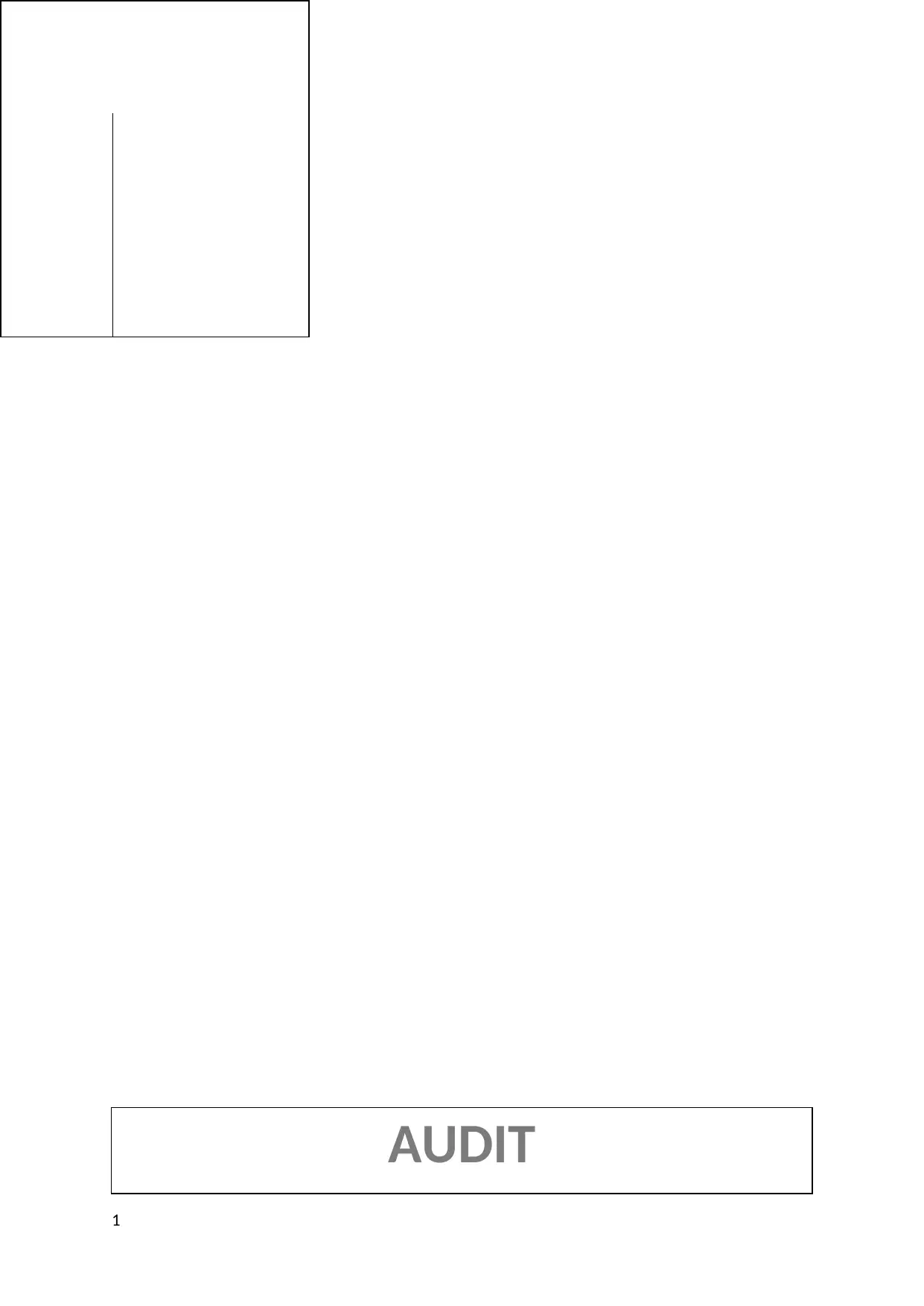
Audit
1
2019
AUDIT
1
2019
AUDIT
Paraphrase This Document
Need a fresh take? Get an instant paraphrase of this document with our AI Paraphraser
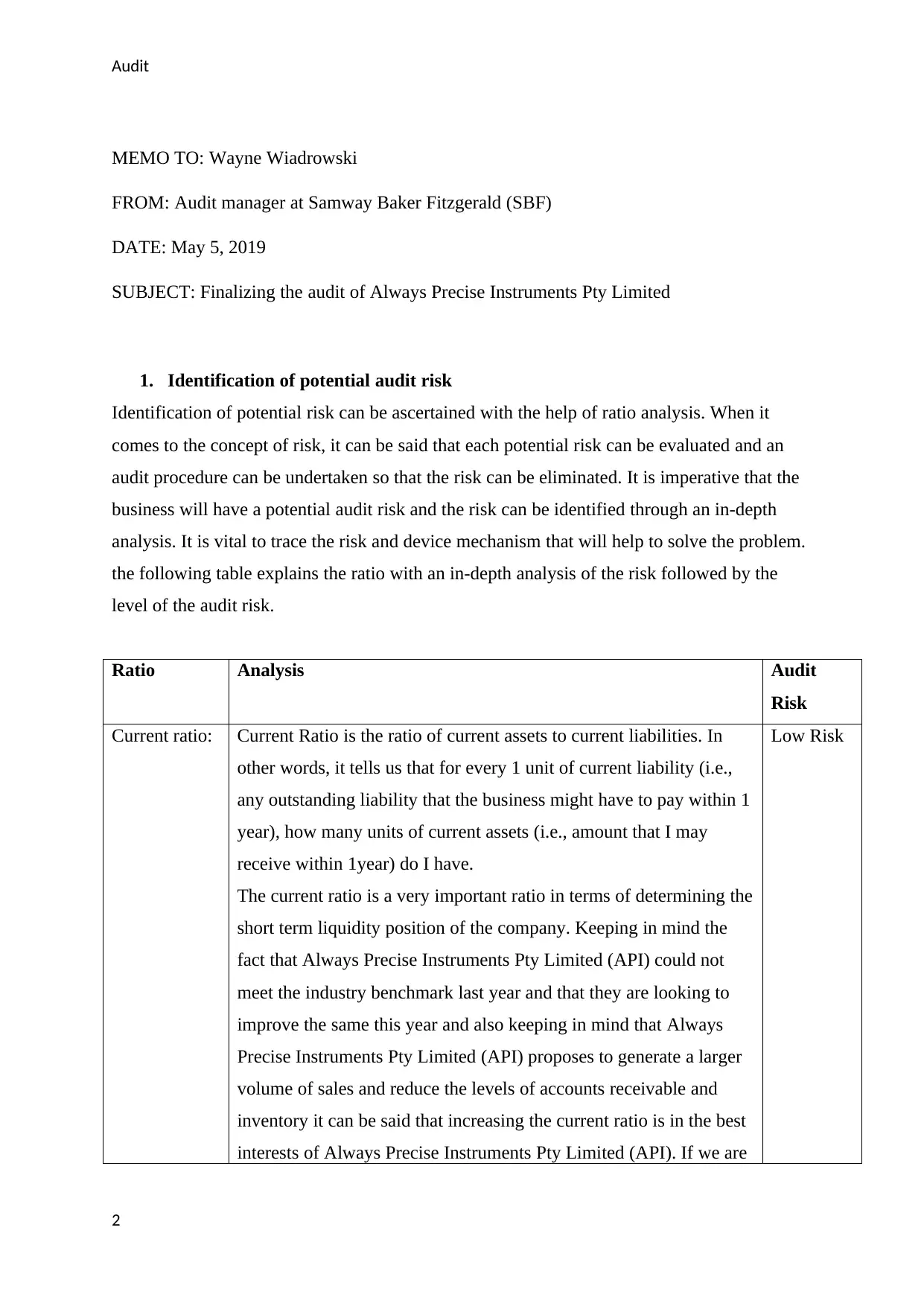
Audit
MEMO TO: Wayne Wiadrowski
FROM: Audit manager at Samway Baker Fitzgerald (SBF)
DATE: May 5, 2019
SUBJECT: Finalizing the audit of Always Precise Instruments Pty Limited
1. Identification of potential audit risk
Identification of potential risk can be ascertained with the help of ratio analysis. When it
comes to the concept of risk, it can be said that each potential risk can be evaluated and an
audit procedure can be undertaken so that the risk can be eliminated. It is imperative that the
business will have a potential audit risk and the risk can be identified through an in-depth
analysis. It is vital to trace the risk and device mechanism that will help to solve the problem.
the following table explains the ratio with an in-depth analysis of the risk followed by the
level of the audit risk.
Ratio Analysis Audit
Risk
Current ratio: Current Ratio is the ratio of current assets to current liabilities. In
other words, it tells us that for every 1 unit of current liability (i.e.,
any outstanding liability that the business might have to pay within 1
year), how many units of current assets (i.e., amount that I may
receive within 1year) do I have.
The current ratio is a very important ratio in terms of determining the
short term liquidity position of the company. Keeping in mind the
fact that Always Precise Instruments Pty Limited (API) could not
meet the industry benchmark last year and that they are looking to
improve the same this year and also keeping in mind that Always
Precise Instruments Pty Limited (API) proposes to generate a larger
volume of sales and reduce the levels of accounts receivable and
inventory it can be said that increasing the current ratio is in the best
interests of Always Precise Instruments Pty Limited (API). If we are
Low Risk
2
MEMO TO: Wayne Wiadrowski
FROM: Audit manager at Samway Baker Fitzgerald (SBF)
DATE: May 5, 2019
SUBJECT: Finalizing the audit of Always Precise Instruments Pty Limited
1. Identification of potential audit risk
Identification of potential risk can be ascertained with the help of ratio analysis. When it
comes to the concept of risk, it can be said that each potential risk can be evaluated and an
audit procedure can be undertaken so that the risk can be eliminated. It is imperative that the
business will have a potential audit risk and the risk can be identified through an in-depth
analysis. It is vital to trace the risk and device mechanism that will help to solve the problem.
the following table explains the ratio with an in-depth analysis of the risk followed by the
level of the audit risk.
Ratio Analysis Audit
Risk
Current ratio: Current Ratio is the ratio of current assets to current liabilities. In
other words, it tells us that for every 1 unit of current liability (i.e.,
any outstanding liability that the business might have to pay within 1
year), how many units of current assets (i.e., amount that I may
receive within 1year) do I have.
The current ratio is a very important ratio in terms of determining the
short term liquidity position of the company. Keeping in mind the
fact that Always Precise Instruments Pty Limited (API) could not
meet the industry benchmark last year and that they are looking to
improve the same this year and also keeping in mind that Always
Precise Instruments Pty Limited (API) proposes to generate a larger
volume of sales and reduce the levels of accounts receivable and
inventory it can be said that increasing the current ratio is in the best
interests of Always Precise Instruments Pty Limited (API). If we are
Low Risk
2
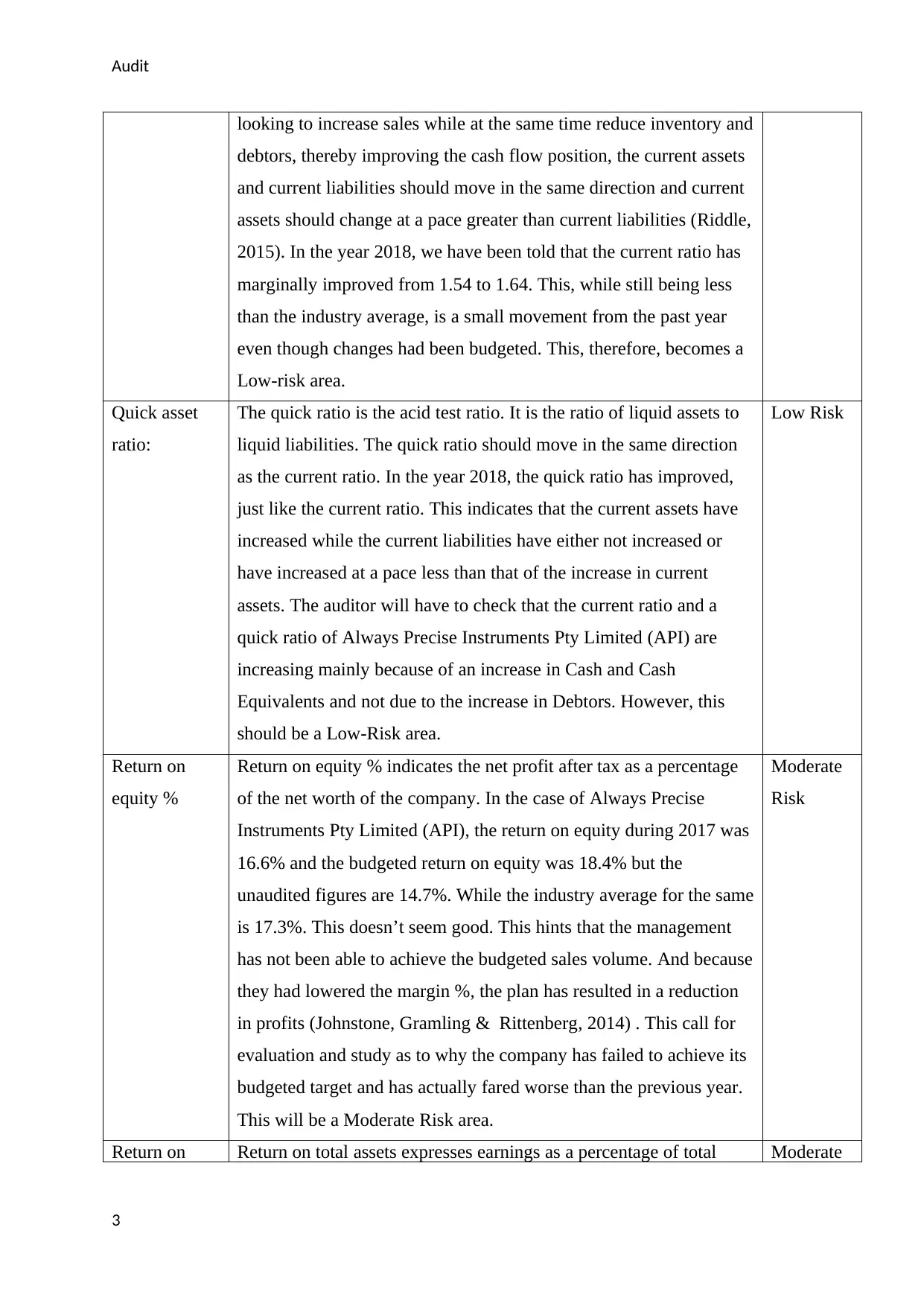
Audit
looking to increase sales while at the same time reduce inventory and
debtors, thereby improving the cash flow position, the current assets
and current liabilities should move in the same direction and current
assets should change at a pace greater than current liabilities (Riddle,
2015). In the year 2018, we have been told that the current ratio has
marginally improved from 1.54 to 1.64. This, while still being less
than the industry average, is a small movement from the past year
even though changes had been budgeted. This, therefore, becomes a
Low-risk area.
Quick asset
ratio:
The quick ratio is the acid test ratio. It is the ratio of liquid assets to
liquid liabilities. The quick ratio should move in the same direction
as the current ratio. In the year 2018, the quick ratio has improved,
just like the current ratio. This indicates that the current assets have
increased while the current liabilities have either not increased or
have increased at a pace less than that of the increase in current
assets. The auditor will have to check that the current ratio and a
quick ratio of Always Precise Instruments Pty Limited (API) are
increasing mainly because of an increase in Cash and Cash
Equivalents and not due to the increase in Debtors. However, this
should be a Low-Risk area.
Low Risk
Return on
equity %
Return on equity % indicates the net profit after tax as a percentage
of the net worth of the company. In the case of Always Precise
Instruments Pty Limited (API), the return on equity during 2017 was
16.6% and the budgeted return on equity was 18.4% but the
unaudited figures are 14.7%. While the industry average for the same
is 17.3%. This doesn’t seem good. This hints that the management
has not been able to achieve the budgeted sales volume. And because
they had lowered the margin %, the plan has resulted in a reduction
in profits (Johnstone, Gramling & Rittenberg, 2014) . This call for
evaluation and study as to why the company has failed to achieve its
budgeted target and has actually fared worse than the previous year.
This will be a Moderate Risk area.
Moderate
Risk
Return on Return on total assets expresses earnings as a percentage of total Moderate
3
looking to increase sales while at the same time reduce inventory and
debtors, thereby improving the cash flow position, the current assets
and current liabilities should move in the same direction and current
assets should change at a pace greater than current liabilities (Riddle,
2015). In the year 2018, we have been told that the current ratio has
marginally improved from 1.54 to 1.64. This, while still being less
than the industry average, is a small movement from the past year
even though changes had been budgeted. This, therefore, becomes a
Low-risk area.
Quick asset
ratio:
The quick ratio is the acid test ratio. It is the ratio of liquid assets to
liquid liabilities. The quick ratio should move in the same direction
as the current ratio. In the year 2018, the quick ratio has improved,
just like the current ratio. This indicates that the current assets have
increased while the current liabilities have either not increased or
have increased at a pace less than that of the increase in current
assets. The auditor will have to check that the current ratio and a
quick ratio of Always Precise Instruments Pty Limited (API) are
increasing mainly because of an increase in Cash and Cash
Equivalents and not due to the increase in Debtors. However, this
should be a Low-Risk area.
Low Risk
Return on
equity %
Return on equity % indicates the net profit after tax as a percentage
of the net worth of the company. In the case of Always Precise
Instruments Pty Limited (API), the return on equity during 2017 was
16.6% and the budgeted return on equity was 18.4% but the
unaudited figures are 14.7%. While the industry average for the same
is 17.3%. This doesn’t seem good. This hints that the management
has not been able to achieve the budgeted sales volume. And because
they had lowered the margin %, the plan has resulted in a reduction
in profits (Johnstone, Gramling & Rittenberg, 2014) . This call for
evaluation and study as to why the company has failed to achieve its
budgeted target and has actually fared worse than the previous year.
This will be a Moderate Risk area.
Moderate
Risk
Return on Return on total assets expresses earnings as a percentage of total Moderate
3
You're viewing a preview
Unlock full access by subscribing today!
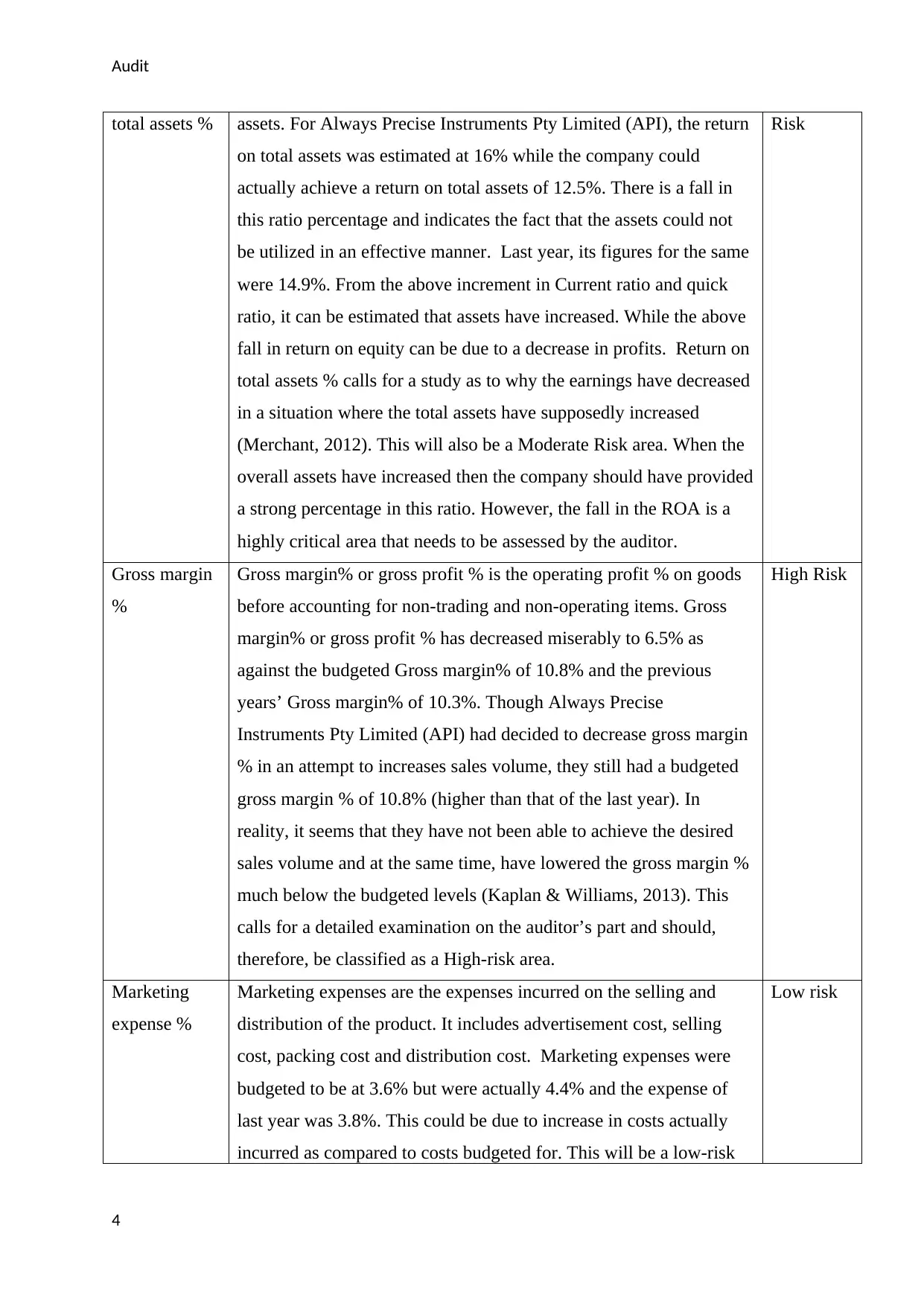
Audit
total assets % assets. For Always Precise Instruments Pty Limited (API), the return
on total assets was estimated at 16% while the company could
actually achieve a return on total assets of 12.5%. There is a fall in
this ratio percentage and indicates the fact that the assets could not
be utilized in an effective manner. Last year, its figures for the same
were 14.9%. From the above increment in Current ratio and quick
ratio, it can be estimated that assets have increased. While the above
fall in return on equity can be due to a decrease in profits. Return on
total assets % calls for a study as to why the earnings have decreased
in a situation where the total assets have supposedly increased
(Merchant, 2012). This will also be a Moderate Risk area. When the
overall assets have increased then the company should have provided
a strong percentage in this ratio. However, the fall in the ROA is a
highly critical area that needs to be assessed by the auditor.
Risk
Gross margin
%
Gross margin% or gross profit % is the operating profit % on goods
before accounting for non-trading and non-operating items. Gross
margin% or gross profit % has decreased miserably to 6.5% as
against the budgeted Gross margin% of 10.8% and the previous
years’ Gross margin% of 10.3%. Though Always Precise
Instruments Pty Limited (API) had decided to decrease gross margin
% in an attempt to increases sales volume, they still had a budgeted
gross margin % of 10.8% (higher than that of the last year). In
reality, it seems that they have not been able to achieve the desired
sales volume and at the same time, have lowered the gross margin %
much below the budgeted levels (Kaplan & Williams, 2013). This
calls for a detailed examination on the auditor’s part and should,
therefore, be classified as a High-risk area.
High Risk
Marketing
expense %
Marketing expenses are the expenses incurred on the selling and
distribution of the product. It includes advertisement cost, selling
cost, packing cost and distribution cost. Marketing expenses were
budgeted to be at 3.6% but were actually 4.4% and the expense of
last year was 3.8%. This could be due to increase in costs actually
incurred as compared to costs budgeted for. This will be a low-risk
Low risk
4
total assets % assets. For Always Precise Instruments Pty Limited (API), the return
on total assets was estimated at 16% while the company could
actually achieve a return on total assets of 12.5%. There is a fall in
this ratio percentage and indicates the fact that the assets could not
be utilized in an effective manner. Last year, its figures for the same
were 14.9%. From the above increment in Current ratio and quick
ratio, it can be estimated that assets have increased. While the above
fall in return on equity can be due to a decrease in profits. Return on
total assets % calls for a study as to why the earnings have decreased
in a situation where the total assets have supposedly increased
(Merchant, 2012). This will also be a Moderate Risk area. When the
overall assets have increased then the company should have provided
a strong percentage in this ratio. However, the fall in the ROA is a
highly critical area that needs to be assessed by the auditor.
Risk
Gross margin
%
Gross margin% or gross profit % is the operating profit % on goods
before accounting for non-trading and non-operating items. Gross
margin% or gross profit % has decreased miserably to 6.5% as
against the budgeted Gross margin% of 10.8% and the previous
years’ Gross margin% of 10.3%. Though Always Precise
Instruments Pty Limited (API) had decided to decrease gross margin
% in an attempt to increases sales volume, they still had a budgeted
gross margin % of 10.8% (higher than that of the last year). In
reality, it seems that they have not been able to achieve the desired
sales volume and at the same time, have lowered the gross margin %
much below the budgeted levels (Kaplan & Williams, 2013). This
calls for a detailed examination on the auditor’s part and should,
therefore, be classified as a High-risk area.
High Risk
Marketing
expense %
Marketing expenses are the expenses incurred on the selling and
distribution of the product. It includes advertisement cost, selling
cost, packing cost and distribution cost. Marketing expenses were
budgeted to be at 3.6% but were actually 4.4% and the expense of
last year was 3.8%. This could be due to increase in costs actually
incurred as compared to costs budgeted for. This will be a low-risk
Low risk
4
Paraphrase This Document
Need a fresh take? Get an instant paraphrase of this document with our AI Paraphraser
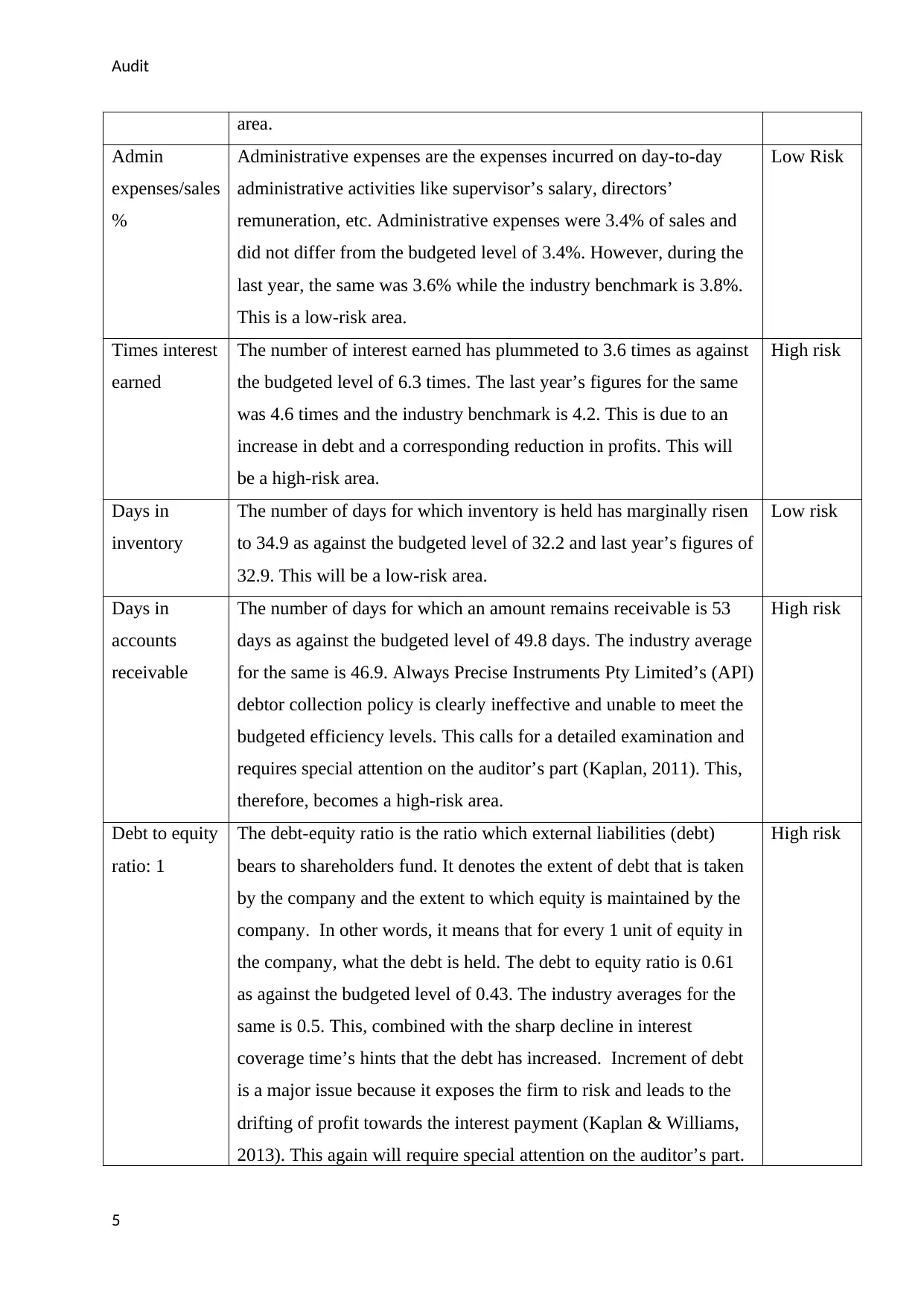
Audit
area.
Admin
expenses/sales
%
Administrative expenses are the expenses incurred on day-to-day
administrative activities like supervisor’s salary, directors’
remuneration, etc. Administrative expenses were 3.4% of sales and
did not differ from the budgeted level of 3.4%. However, during the
last year, the same was 3.6% while the industry benchmark is 3.8%.
This is a low-risk area.
Low Risk
Times interest
earned
The number of interest earned has plummeted to 3.6 times as against
the budgeted level of 6.3 times. The last year’s figures for the same
was 4.6 times and the industry benchmark is 4.2. This is due to an
increase in debt and a corresponding reduction in profits. This will
be a high-risk area.
High risk
Days in
inventory
The number of days for which inventory is held has marginally risen
to 34.9 as against the budgeted level of 32.2 and last year’s figures of
32.9. This will be a low-risk area.
Low risk
Days in
accounts
receivable
The number of days for which an amount remains receivable is 53
days as against the budgeted level of 49.8 days. The industry average
for the same is 46.9. Always Precise Instruments Pty Limited’s (API)
debtor collection policy is clearly ineffective and unable to meet the
budgeted efficiency levels. This calls for a detailed examination and
requires special attention on the auditor’s part (Kaplan, 2011). This,
therefore, becomes a high-risk area.
High risk
Debt to equity
ratio: 1
The debt-equity ratio is the ratio which external liabilities (debt)
bears to shareholders fund. It denotes the extent of debt that is taken
by the company and the extent to which equity is maintained by the
company. In other words, it means that for every 1 unit of equity in
the company, what the debt is held. The debt to equity ratio is 0.61
as against the budgeted level of 0.43. The industry averages for the
same is 0.5. This, combined with the sharp decline in interest
coverage time’s hints that the debt has increased. Increment of debt
is a major issue because it exposes the firm to risk and leads to the
drifting of profit towards the interest payment (Kaplan & Williams,
2013). This again will require special attention on the auditor’s part.
High risk
5
area.
Admin
expenses/sales
%
Administrative expenses are the expenses incurred on day-to-day
administrative activities like supervisor’s salary, directors’
remuneration, etc. Administrative expenses were 3.4% of sales and
did not differ from the budgeted level of 3.4%. However, during the
last year, the same was 3.6% while the industry benchmark is 3.8%.
This is a low-risk area.
Low Risk
Times interest
earned
The number of interest earned has plummeted to 3.6 times as against
the budgeted level of 6.3 times. The last year’s figures for the same
was 4.6 times and the industry benchmark is 4.2. This is due to an
increase in debt and a corresponding reduction in profits. This will
be a high-risk area.
High risk
Days in
inventory
The number of days for which inventory is held has marginally risen
to 34.9 as against the budgeted level of 32.2 and last year’s figures of
32.9. This will be a low-risk area.
Low risk
Days in
accounts
receivable
The number of days for which an amount remains receivable is 53
days as against the budgeted level of 49.8 days. The industry average
for the same is 46.9. Always Precise Instruments Pty Limited’s (API)
debtor collection policy is clearly ineffective and unable to meet the
budgeted efficiency levels. This calls for a detailed examination and
requires special attention on the auditor’s part (Kaplan, 2011). This,
therefore, becomes a high-risk area.
High risk
Debt to equity
ratio: 1
The debt-equity ratio is the ratio which external liabilities (debt)
bears to shareholders fund. It denotes the extent of debt that is taken
by the company and the extent to which equity is maintained by the
company. In other words, it means that for every 1 unit of equity in
the company, what the debt is held. The debt to equity ratio is 0.61
as against the budgeted level of 0.43. The industry averages for the
same is 0.5. This, combined with the sharp decline in interest
coverage time’s hints that the debt has increased. Increment of debt
is a major issue because it exposes the firm to risk and leads to the
drifting of profit towards the interest payment (Kaplan & Williams,
2013). This again will require special attention on the auditor’s part.
High risk
5
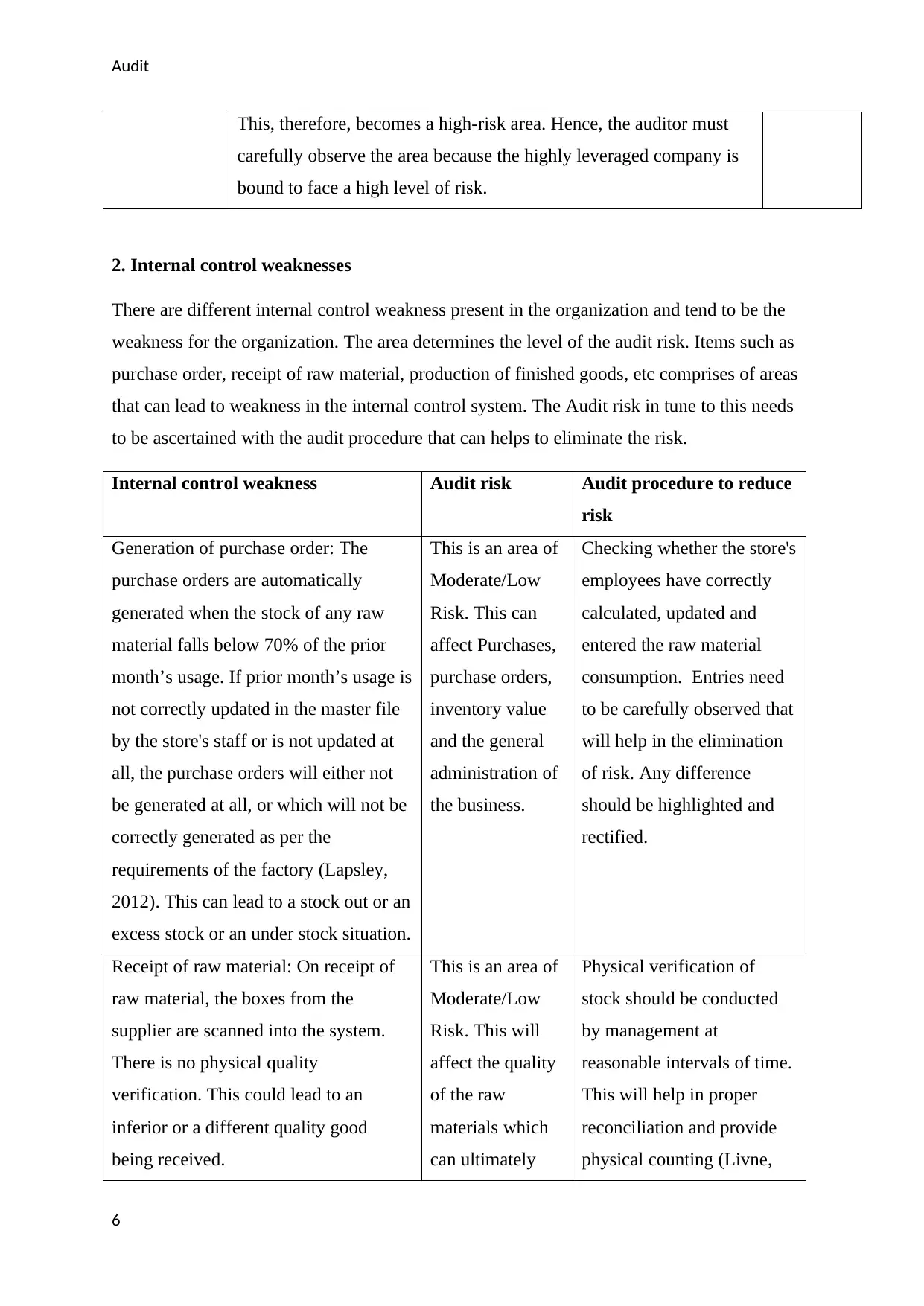
Audit
This, therefore, becomes a high-risk area. Hence, the auditor must
carefully observe the area because the highly leveraged company is
bound to face a high level of risk.
2. Internal control weaknesses
There are different internal control weakness present in the organization and tend to be the
weakness for the organization. The area determines the level of the audit risk. Items such as
purchase order, receipt of raw material, production of finished goods, etc comprises of areas
that can lead to weakness in the internal control system. The Audit risk in tune to this needs
to be ascertained with the audit procedure that can helps to eliminate the risk.
Internal control weakness Audit risk Audit procedure to reduce
risk
Generation of purchase order: The
purchase orders are automatically
generated when the stock of any raw
material falls below 70% of the prior
month’s usage. If prior month’s usage is
not correctly updated in the master file
by the store's staff or is not updated at
all, the purchase orders will either not
be generated at all, or which will not be
correctly generated as per the
requirements of the factory (Lapsley,
2012). This can lead to a stock out or an
excess stock or an under stock situation.
This is an area of
Moderate/Low
Risk. This can
affect Purchases,
purchase orders,
inventory value
and the general
administration of
the business.
Checking whether the store's
employees have correctly
calculated, updated and
entered the raw material
consumption. Entries need
to be carefully observed that
will help in the elimination
of risk. Any difference
should be highlighted and
rectified.
Receipt of raw material: On receipt of
raw material, the boxes from the
supplier are scanned into the system.
There is no physical quality
verification. This could lead to an
inferior or a different quality good
being received.
This is an area of
Moderate/Low
Risk. This will
affect the quality
of the raw
materials which
can ultimately
Physical verification of
stock should be conducted
by management at
reasonable intervals of time.
This will help in proper
reconciliation and provide
physical counting (Livne,
6
This, therefore, becomes a high-risk area. Hence, the auditor must
carefully observe the area because the highly leveraged company is
bound to face a high level of risk.
2. Internal control weaknesses
There are different internal control weakness present in the organization and tend to be the
weakness for the organization. The area determines the level of the audit risk. Items such as
purchase order, receipt of raw material, production of finished goods, etc comprises of areas
that can lead to weakness in the internal control system. The Audit risk in tune to this needs
to be ascertained with the audit procedure that can helps to eliminate the risk.
Internal control weakness Audit risk Audit procedure to reduce
risk
Generation of purchase order: The
purchase orders are automatically
generated when the stock of any raw
material falls below 70% of the prior
month’s usage. If prior month’s usage is
not correctly updated in the master file
by the store's staff or is not updated at
all, the purchase orders will either not
be generated at all, or which will not be
correctly generated as per the
requirements of the factory (Lapsley,
2012). This can lead to a stock out or an
excess stock or an under stock situation.
This is an area of
Moderate/Low
Risk. This can
affect Purchases,
purchase orders,
inventory value
and the general
administration of
the business.
Checking whether the store's
employees have correctly
calculated, updated and
entered the raw material
consumption. Entries need
to be carefully observed that
will help in the elimination
of risk. Any difference
should be highlighted and
rectified.
Receipt of raw material: On receipt of
raw material, the boxes from the
supplier are scanned into the system.
There is no physical quality
verification. This could lead to an
inferior or a different quality good
being received.
This is an area of
Moderate/Low
Risk. This will
affect the quality
of the raw
materials which
can ultimately
Physical verification of
stock should be conducted
by management at
reasonable intervals of time.
This will help in proper
reconciliation and provide
physical counting (Livne,
6
You're viewing a preview
Unlock full access by subscribing today!
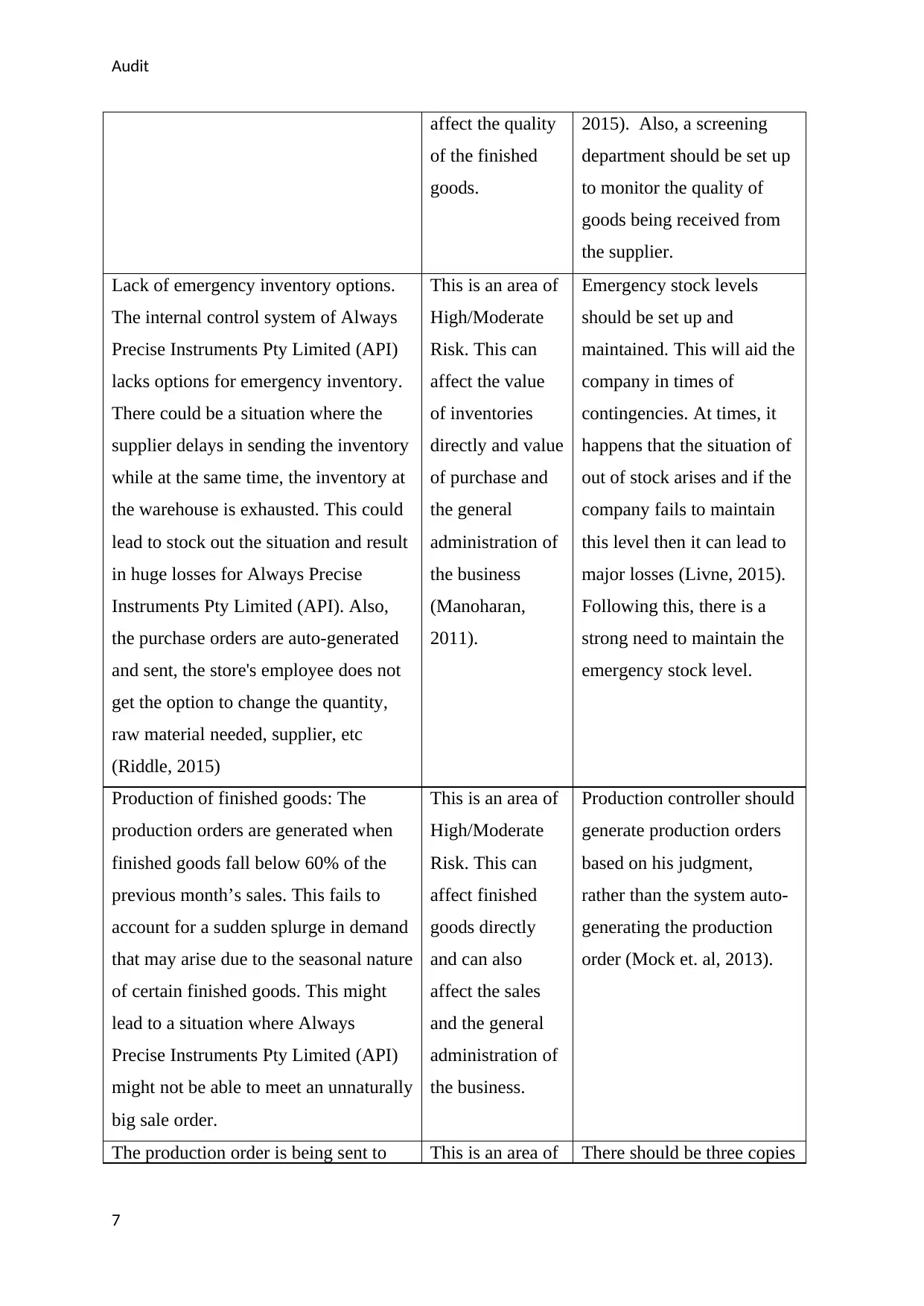
Audit
affect the quality
of the finished
goods.
2015). Also, a screening
department should be set up
to monitor the quality of
goods being received from
the supplier.
Lack of emergency inventory options.
The internal control system of Always
Precise Instruments Pty Limited (API)
lacks options for emergency inventory.
There could be a situation where the
supplier delays in sending the inventory
while at the same time, the inventory at
the warehouse is exhausted. This could
lead to stock out the situation and result
in huge losses for Always Precise
Instruments Pty Limited (API). Also,
the purchase orders are auto-generated
and sent, the store's employee does not
get the option to change the quantity,
raw material needed, supplier, etc
(Riddle, 2015)
This is an area of
High/Moderate
Risk. This can
affect the value
of inventories
directly and value
of purchase and
the general
administration of
the business
(Manoharan,
2011).
Emergency stock levels
should be set up and
maintained. This will aid the
company in times of
contingencies. At times, it
happens that the situation of
out of stock arises and if the
company fails to maintain
this level then it can lead to
major losses (Livne, 2015).
Following this, there is a
strong need to maintain the
emergency stock level.
Production of finished goods: The
production orders are generated when
finished goods fall below 60% of the
previous month’s sales. This fails to
account for a sudden splurge in demand
that may arise due to the seasonal nature
of certain finished goods. This might
lead to a situation where Always
Precise Instruments Pty Limited (API)
might not be able to meet an unnaturally
big sale order.
This is an area of
High/Moderate
Risk. This can
affect finished
goods directly
and can also
affect the sales
and the general
administration of
the business.
Production controller should
generate production orders
based on his judgment,
rather than the system auto-
generating the production
order (Mock et. al, 2013).
The production order is being sent to This is an area of There should be three copies
7
affect the quality
of the finished
goods.
2015). Also, a screening
department should be set up
to monitor the quality of
goods being received from
the supplier.
Lack of emergency inventory options.
The internal control system of Always
Precise Instruments Pty Limited (API)
lacks options for emergency inventory.
There could be a situation where the
supplier delays in sending the inventory
while at the same time, the inventory at
the warehouse is exhausted. This could
lead to stock out the situation and result
in huge losses for Always Precise
Instruments Pty Limited (API). Also,
the purchase orders are auto-generated
and sent, the store's employee does not
get the option to change the quantity,
raw material needed, supplier, etc
(Riddle, 2015)
This is an area of
High/Moderate
Risk. This can
affect the value
of inventories
directly and value
of purchase and
the general
administration of
the business
(Manoharan,
2011).
Emergency stock levels
should be set up and
maintained. This will aid the
company in times of
contingencies. At times, it
happens that the situation of
out of stock arises and if the
company fails to maintain
this level then it can lead to
major losses (Livne, 2015).
Following this, there is a
strong need to maintain the
emergency stock level.
Production of finished goods: The
production orders are generated when
finished goods fall below 60% of the
previous month’s sales. This fails to
account for a sudden splurge in demand
that may arise due to the seasonal nature
of certain finished goods. This might
lead to a situation where Always
Precise Instruments Pty Limited (API)
might not be able to meet an unnaturally
big sale order.
This is an area of
High/Moderate
Risk. This can
affect finished
goods directly
and can also
affect the sales
and the general
administration of
the business.
Production controller should
generate production orders
based on his judgment,
rather than the system auto-
generating the production
order (Mock et. al, 2013).
The production order is being sent to This is an area of There should be three copies
7
Paraphrase This Document
Need a fresh take? Get an instant paraphrase of this document with our AI Paraphraser
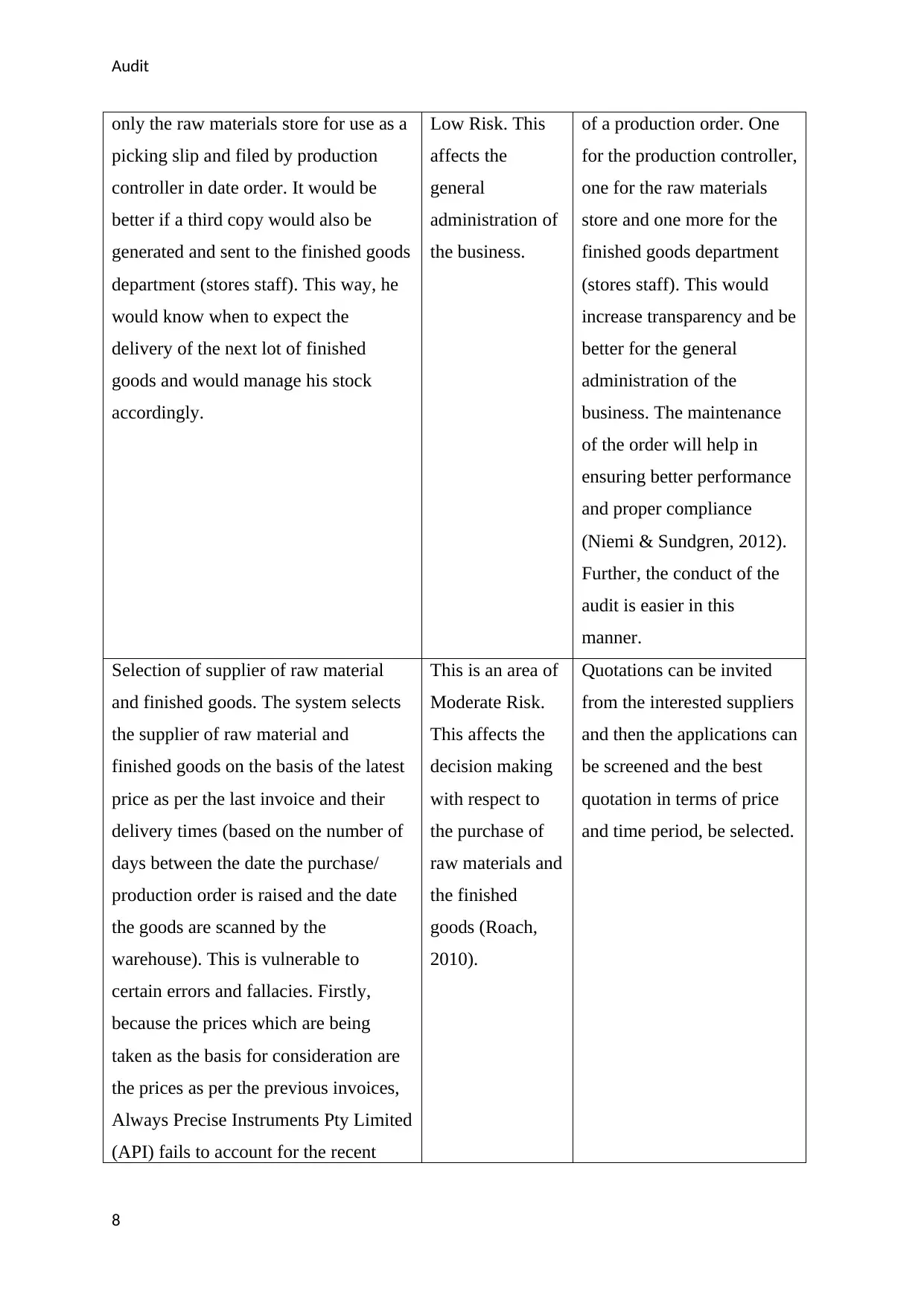
Audit
only the raw materials store for use as a
picking slip and filed by production
controller in date order. It would be
better if a third copy would also be
generated and sent to the finished goods
department (stores staff). This way, he
would know when to expect the
delivery of the next lot of finished
goods and would manage his stock
accordingly.
Low Risk. This
affects the
general
administration of
the business.
of a production order. One
for the production controller,
one for the raw materials
store and one more for the
finished goods department
(stores staff). This would
increase transparency and be
better for the general
administration of the
business. The maintenance
of the order will help in
ensuring better performance
and proper compliance
(Niemi & Sundgren, 2012).
Further, the conduct of the
audit is easier in this
manner.
Selection of supplier of raw material
and finished goods. The system selects
the supplier of raw material and
finished goods on the basis of the latest
price as per the last invoice and their
delivery times (based on the number of
days between the date the purchase/
production order is raised and the date
the goods are scanned by the
warehouse). This is vulnerable to
certain errors and fallacies. Firstly,
because the prices which are being
taken as the basis for consideration are
the prices as per the previous invoices,
Always Precise Instruments Pty Limited
(API) fails to account for the recent
This is an area of
Moderate Risk.
This affects the
decision making
with respect to
the purchase of
raw materials and
the finished
goods (Roach,
2010).
Quotations can be invited
from the interested suppliers
and then the applications can
be screened and the best
quotation in terms of price
and time period, be selected.
8
only the raw materials store for use as a
picking slip and filed by production
controller in date order. It would be
better if a third copy would also be
generated and sent to the finished goods
department (stores staff). This way, he
would know when to expect the
delivery of the next lot of finished
goods and would manage his stock
accordingly.
Low Risk. This
affects the
general
administration of
the business.
of a production order. One
for the production controller,
one for the raw materials
store and one more for the
finished goods department
(stores staff). This would
increase transparency and be
better for the general
administration of the
business. The maintenance
of the order will help in
ensuring better performance
and proper compliance
(Niemi & Sundgren, 2012).
Further, the conduct of the
audit is easier in this
manner.
Selection of supplier of raw material
and finished goods. The system selects
the supplier of raw material and
finished goods on the basis of the latest
price as per the last invoice and their
delivery times (based on the number of
days between the date the purchase/
production order is raised and the date
the goods are scanned by the
warehouse). This is vulnerable to
certain errors and fallacies. Firstly,
because the prices which are being
taken as the basis for consideration are
the prices as per the previous invoices,
Always Precise Instruments Pty Limited
(API) fails to account for the recent
This is an area of
Moderate Risk.
This affects the
decision making
with respect to
the purchase of
raw materials and
the finished
goods (Roach,
2010).
Quotations can be invited
from the interested suppliers
and then the applications can
be screened and the best
quotation in terms of price
and time period, be selected.
8
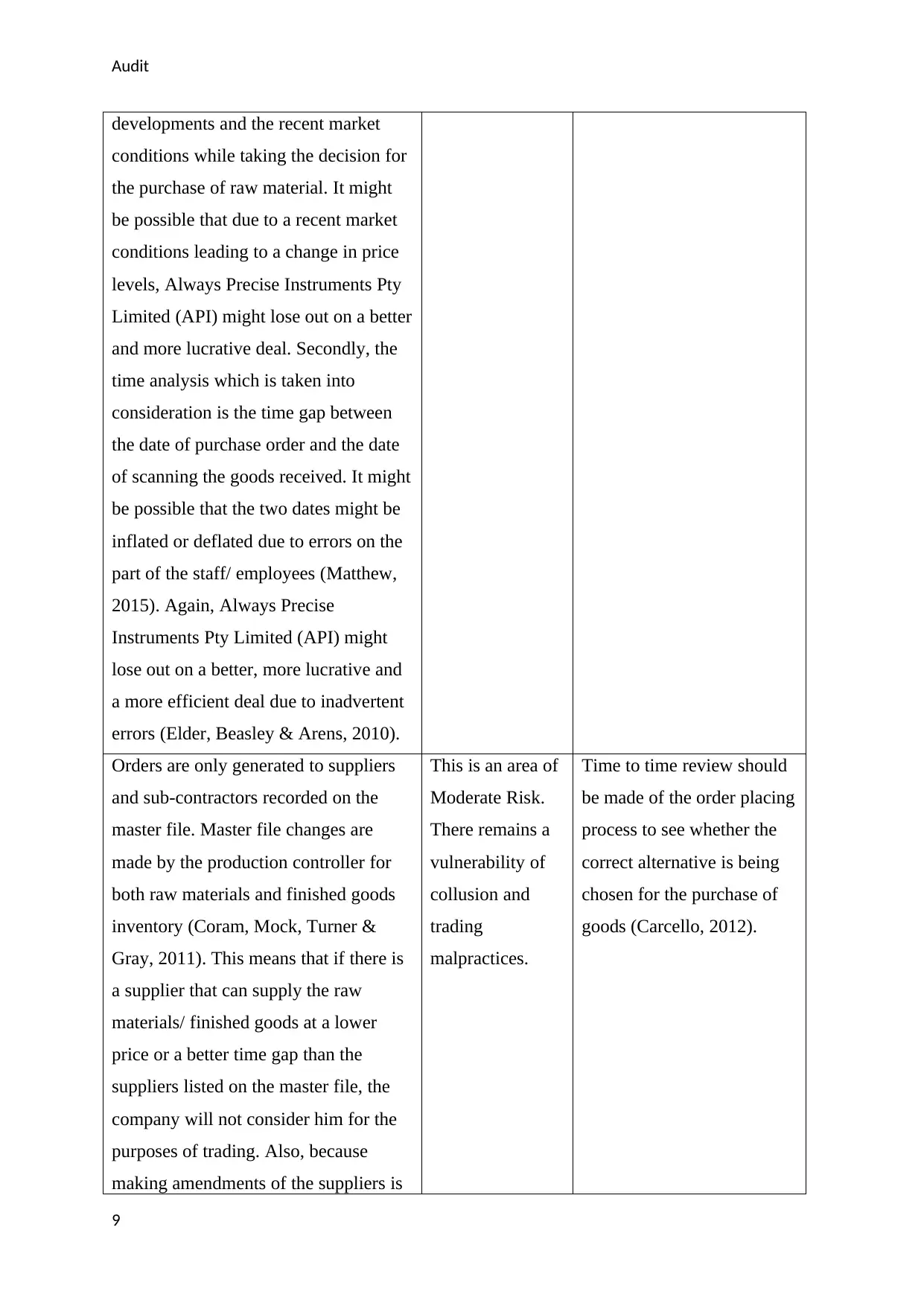
Audit
developments and the recent market
conditions while taking the decision for
the purchase of raw material. It might
be possible that due to a recent market
conditions leading to a change in price
levels, Always Precise Instruments Pty
Limited (API) might lose out on a better
and more lucrative deal. Secondly, the
time analysis which is taken into
consideration is the time gap between
the date of purchase order and the date
of scanning the goods received. It might
be possible that the two dates might be
inflated or deflated due to errors on the
part of the staff/ employees (Matthew,
2015). Again, Always Precise
Instruments Pty Limited (API) might
lose out on a better, more lucrative and
a more efficient deal due to inadvertent
errors (Elder, Beasley & Arens, 2010).
Orders are only generated to suppliers
and sub-contractors recorded on the
master file. Master file changes are
made by the production controller for
both raw materials and finished goods
inventory (Coram, Mock, Turner &
Gray, 2011). This means that if there is
a supplier that can supply the raw
materials/ finished goods at a lower
price or a better time gap than the
suppliers listed on the master file, the
company will not consider him for the
purposes of trading. Also, because
making amendments of the suppliers is
This is an area of
Moderate Risk.
There remains a
vulnerability of
collusion and
trading
malpractices.
Time to time review should
be made of the order placing
process to see whether the
correct alternative is being
chosen for the purchase of
goods (Carcello, 2012).
9
developments and the recent market
conditions while taking the decision for
the purchase of raw material. It might
be possible that due to a recent market
conditions leading to a change in price
levels, Always Precise Instruments Pty
Limited (API) might lose out on a better
and more lucrative deal. Secondly, the
time analysis which is taken into
consideration is the time gap between
the date of purchase order and the date
of scanning the goods received. It might
be possible that the two dates might be
inflated or deflated due to errors on the
part of the staff/ employees (Matthew,
2015). Again, Always Precise
Instruments Pty Limited (API) might
lose out on a better, more lucrative and
a more efficient deal due to inadvertent
errors (Elder, Beasley & Arens, 2010).
Orders are only generated to suppliers
and sub-contractors recorded on the
master file. Master file changes are
made by the production controller for
both raw materials and finished goods
inventory (Coram, Mock, Turner &
Gray, 2011). This means that if there is
a supplier that can supply the raw
materials/ finished goods at a lower
price or a better time gap than the
suppliers listed on the master file, the
company will not consider him for the
purposes of trading. Also, because
making amendments of the suppliers is
This is an area of
Moderate Risk.
There remains a
vulnerability of
collusion and
trading
malpractices.
Time to time review should
be made of the order placing
process to see whether the
correct alternative is being
chosen for the purchase of
goods (Carcello, 2012).
9
You're viewing a preview
Unlock full access by subscribing today!
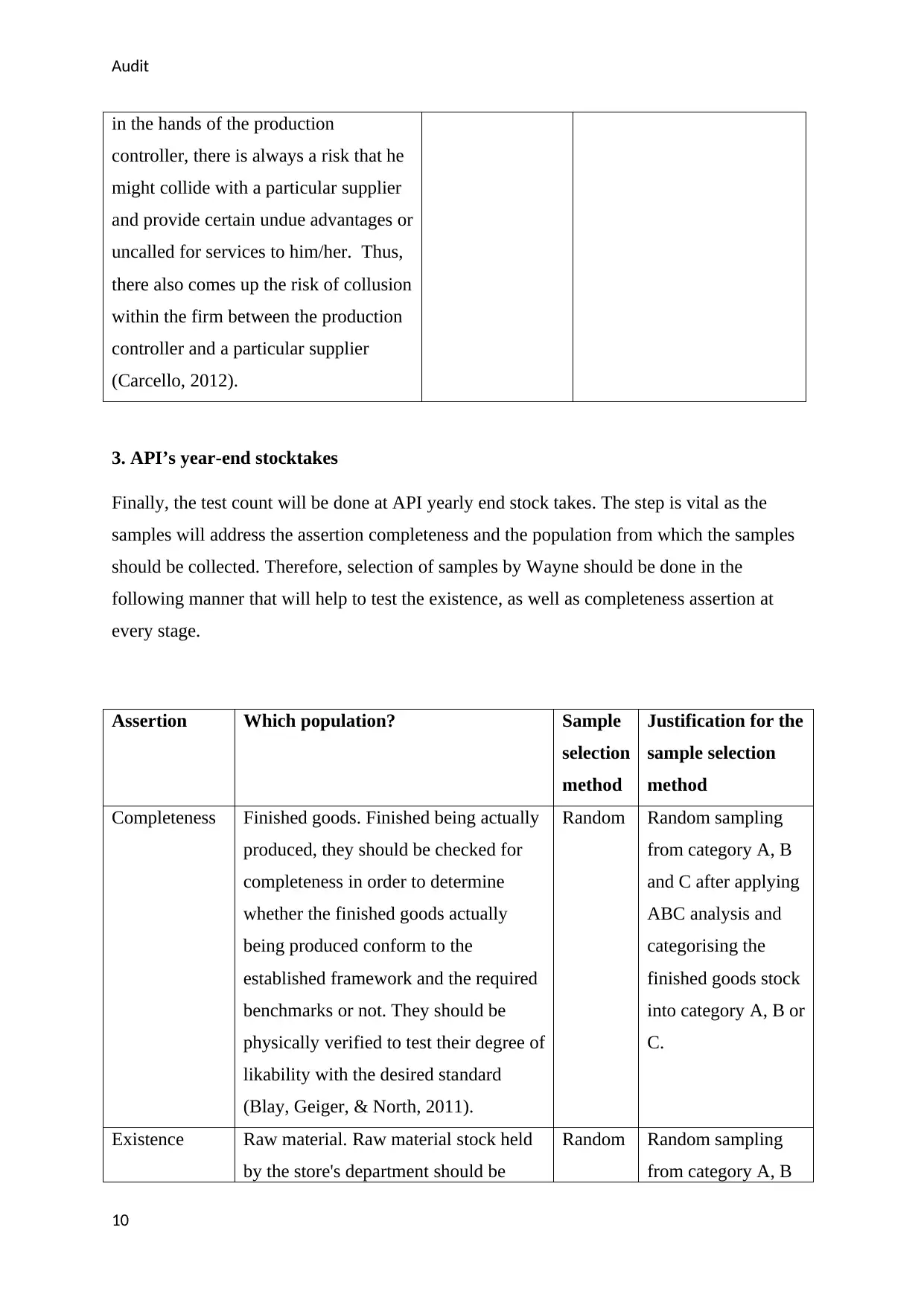
Audit
in the hands of the production
controller, there is always a risk that he
might collide with a particular supplier
and provide certain undue advantages or
uncalled for services to him/her. Thus,
there also comes up the risk of collusion
within the firm between the production
controller and a particular supplier
(Carcello, 2012).
3. API’s year-end stocktakes
Finally, the test count will be done at API yearly end stock takes. The step is vital as the
samples will address the assertion completeness and the population from which the samples
should be collected. Therefore, selection of samples by Wayne should be done in the
following manner that will help to test the existence, as well as completeness assertion at
every stage.
Assertion Which population? Sample
selection
method
Justification for the
sample selection
method
Completeness Finished goods. Finished being actually
produced, they should be checked for
completeness in order to determine
whether the finished goods actually
being produced conform to the
established framework and the required
benchmarks or not. They should be
physically verified to test their degree of
likability with the desired standard
(Blay, Geiger, & North, 2011).
Random Random sampling
from category A, B
and C after applying
ABC analysis and
categorising the
finished goods stock
into category A, B or
C.
Existence Raw material. Raw material stock held
by the store's department should be
Random Random sampling
from category A, B
10
in the hands of the production
controller, there is always a risk that he
might collide with a particular supplier
and provide certain undue advantages or
uncalled for services to him/her. Thus,
there also comes up the risk of collusion
within the firm between the production
controller and a particular supplier
(Carcello, 2012).
3. API’s year-end stocktakes
Finally, the test count will be done at API yearly end stock takes. The step is vital as the
samples will address the assertion completeness and the population from which the samples
should be collected. Therefore, selection of samples by Wayne should be done in the
following manner that will help to test the existence, as well as completeness assertion at
every stage.
Assertion Which population? Sample
selection
method
Justification for the
sample selection
method
Completeness Finished goods. Finished being actually
produced, they should be checked for
completeness in order to determine
whether the finished goods actually
being produced conform to the
established framework and the required
benchmarks or not. They should be
physically verified to test their degree of
likability with the desired standard
(Blay, Geiger, & North, 2011).
Random Random sampling
from category A, B
and C after applying
ABC analysis and
categorising the
finished goods stock
into category A, B or
C.
Existence Raw material. Raw material stock held
by the store's department should be
Random Random sampling
from category A, B
10
Paraphrase This Document
Need a fresh take? Get an instant paraphrase of this document with our AI Paraphraser
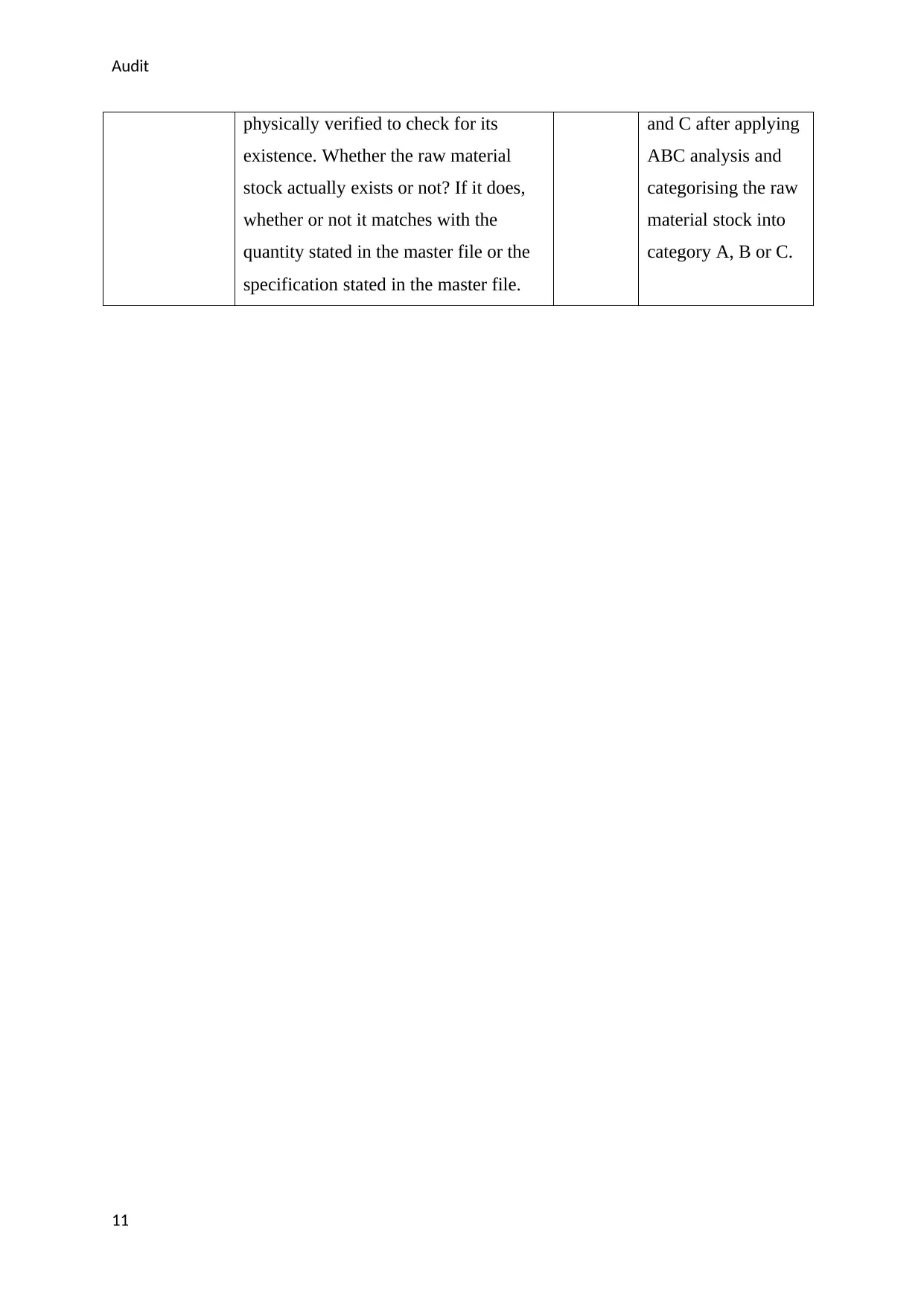
Audit
physically verified to check for its
existence. Whether the raw material
stock actually exists or not? If it does,
whether or not it matches with the
quantity stated in the master file or the
specification stated in the master file.
and C after applying
ABC analysis and
categorising the raw
material stock into
category A, B or C.
11
physically verified to check for its
existence. Whether the raw material
stock actually exists or not? If it does,
whether or not it matches with the
quantity stated in the master file or the
specification stated in the master file.
and C after applying
ABC analysis and
categorising the raw
material stock into
category A, B or C.
11
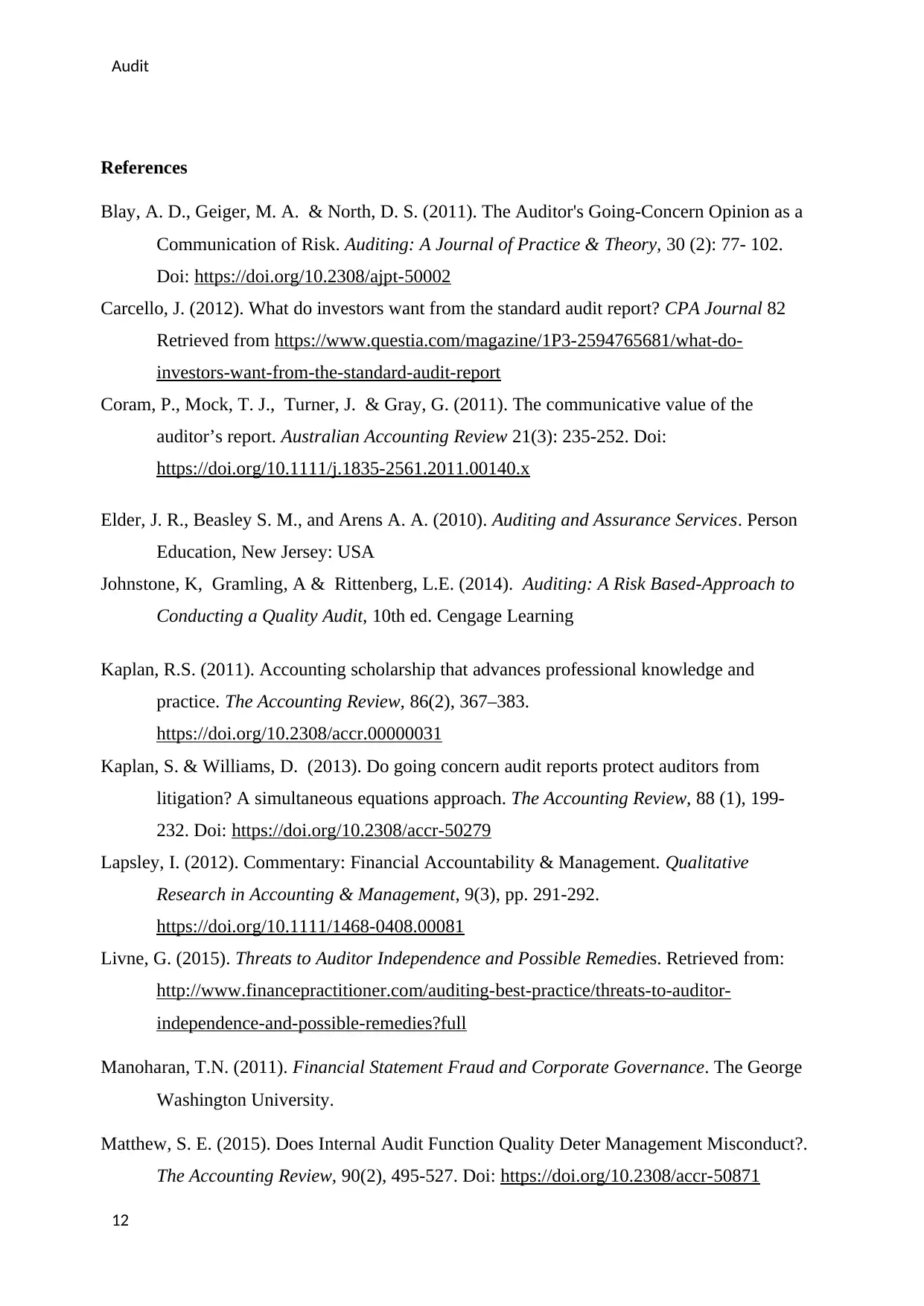
Audit
References
Blay, A. D., Geiger, M. A. & North, D. S. (2011). The Auditor's Going-Concern Opinion as a
Communication of Risk. Auditing: A Journal of Practice & Theory, 30 (2): 77- 102.
Doi: https://doi.org/10.2308/ajpt-50002
Carcello, J. (2012). What do investors want from the standard audit report? CPA Journal 82
Retrieved from https://www.questia.com/magazine/1P3-2594765681/what-do-
investors-want-from-the-standard-audit-report
Coram, P., Mock, T. J., Turner, J. & Gray, G. (2011). The communicative value of the
auditor’s report. Australian Accounting Review 21(3): 235-252. Doi:
https://doi.org/10.1111/j.1835-2561.2011.00140.x
Elder, J. R., Beasley S. M., and Arens A. A. (2010). Auditing and Assurance Services. Person
Education, New Jersey: USA
Johnstone, K, Gramling, A & Rittenberg, L.E. (2014). Auditing: A Risk Based-Approach to
Conducting a Quality Audit, 10th ed. Cengage Learning
Kaplan, R.S. (2011). Accounting scholarship that advances professional knowledge and
practice. The Accounting Review, 86(2), 367–383.
https://doi.org/10.2308/accr.00000031
Kaplan, S. & Williams, D. (2013). Do going concern audit reports protect auditors from
litigation? A simultaneous equations approach. The Accounting Review, 88 (1), 199-
232. Doi: https://doi.org/10.2308/accr-50279
Lapsley, I. (2012). Commentary: Financial Accountability & Management. Qualitative
Research in Accounting & Management, 9(3), pp. 291-292.
https://doi.org/10.1111/1468-0408.00081
Livne, G. (2015). Threats to Auditor Independence and Possible Remedies. Retrieved from:
http://www.financepractitioner.com/auditing-best-practice/threats-to-auditor-
independence-and-possible-remedies?full
Manoharan, T.N. (2011). Financial Statement Fraud and Corporate Governance. The George
Washington University.
Matthew, S. E. (2015). Does Internal Audit Function Quality Deter Management Misconduct?.
The Accounting Review, 90(2), 495-527. Doi: https://doi.org/10.2308/accr-50871
12
References
Blay, A. D., Geiger, M. A. & North, D. S. (2011). The Auditor's Going-Concern Opinion as a
Communication of Risk. Auditing: A Journal of Practice & Theory, 30 (2): 77- 102.
Doi: https://doi.org/10.2308/ajpt-50002
Carcello, J. (2012). What do investors want from the standard audit report? CPA Journal 82
Retrieved from https://www.questia.com/magazine/1P3-2594765681/what-do-
investors-want-from-the-standard-audit-report
Coram, P., Mock, T. J., Turner, J. & Gray, G. (2011). The communicative value of the
auditor’s report. Australian Accounting Review 21(3): 235-252. Doi:
https://doi.org/10.1111/j.1835-2561.2011.00140.x
Elder, J. R., Beasley S. M., and Arens A. A. (2010). Auditing and Assurance Services. Person
Education, New Jersey: USA
Johnstone, K, Gramling, A & Rittenberg, L.E. (2014). Auditing: A Risk Based-Approach to
Conducting a Quality Audit, 10th ed. Cengage Learning
Kaplan, R.S. (2011). Accounting scholarship that advances professional knowledge and
practice. The Accounting Review, 86(2), 367–383.
https://doi.org/10.2308/accr.00000031
Kaplan, S. & Williams, D. (2013). Do going concern audit reports protect auditors from
litigation? A simultaneous equations approach. The Accounting Review, 88 (1), 199-
232. Doi: https://doi.org/10.2308/accr-50279
Lapsley, I. (2012). Commentary: Financial Accountability & Management. Qualitative
Research in Accounting & Management, 9(3), pp. 291-292.
https://doi.org/10.1111/1468-0408.00081
Livne, G. (2015). Threats to Auditor Independence and Possible Remedies. Retrieved from:
http://www.financepractitioner.com/auditing-best-practice/threats-to-auditor-
independence-and-possible-remedies?full
Manoharan, T.N. (2011). Financial Statement Fraud and Corporate Governance. The George
Washington University.
Matthew, S. E. (2015). Does Internal Audit Function Quality Deter Management Misconduct?.
The Accounting Review, 90(2), 495-527. Doi: https://doi.org/10.2308/accr-50871
12
You're viewing a preview
Unlock full access by subscribing today!
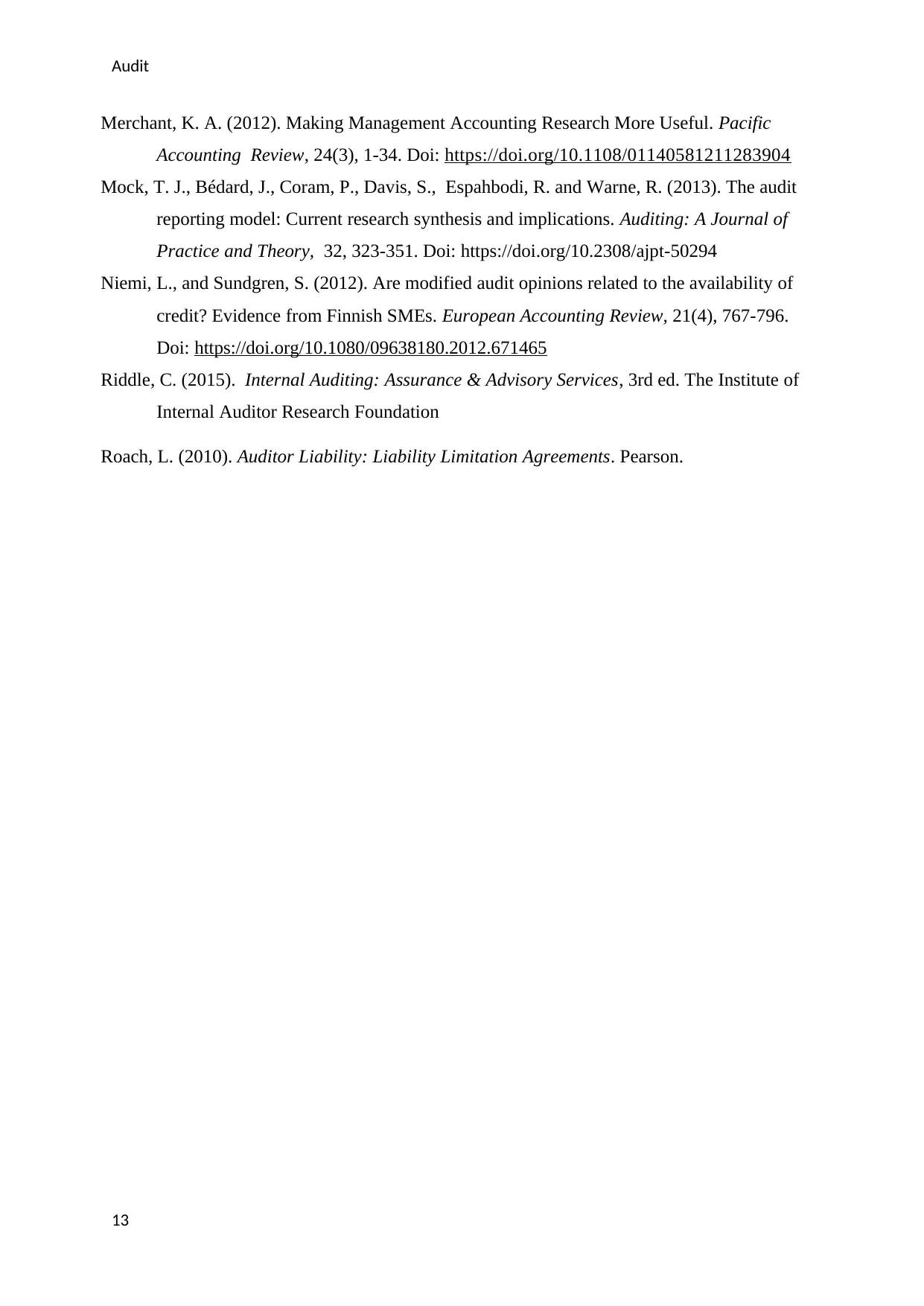
Audit
Merchant, K. A. (2012). Making Management Accounting Research More Useful. Pacific
Accounting Review, 24(3), 1-34. Doi: https://doi.org/10.1108/01140581211283904
Mock, T. J., Bédard, J., Coram, P., Davis, S., Espahbodi, R. and Warne, R. (2013). The audit
reporting model: Current research synthesis and implications. Auditing: A Journal of
Practice and Theory, 32, 323-351. Doi: https://doi.org/10.2308/ajpt-50294
Niemi, L., and Sundgren, S. (2012). Are modified audit opinions related to the availability of
credit? Evidence from Finnish SMEs. European Accounting Review, 21(4), 767-796.
Doi: https://doi.org/10.1080/09638180.2012.671465
Riddle, C. (2015). Internal Auditing: Assurance & Advisory Services, 3rd ed. The Institute of
Internal Auditor Research Foundation
Roach, L. (2010). Auditor Liability: Liability Limitation Agreements. Pearson.
13
Merchant, K. A. (2012). Making Management Accounting Research More Useful. Pacific
Accounting Review, 24(3), 1-34. Doi: https://doi.org/10.1108/01140581211283904
Mock, T. J., Bédard, J., Coram, P., Davis, S., Espahbodi, R. and Warne, R. (2013). The audit
reporting model: Current research synthesis and implications. Auditing: A Journal of
Practice and Theory, 32, 323-351. Doi: https://doi.org/10.2308/ajpt-50294
Niemi, L., and Sundgren, S. (2012). Are modified audit opinions related to the availability of
credit? Evidence from Finnish SMEs. European Accounting Review, 21(4), 767-796.
Doi: https://doi.org/10.1080/09638180.2012.671465
Riddle, C. (2015). Internal Auditing: Assurance & Advisory Services, 3rd ed. The Institute of
Internal Auditor Research Foundation
Roach, L. (2010). Auditor Liability: Liability Limitation Agreements. Pearson.
13
1 out of 13
Related Documents
Your All-in-One AI-Powered Toolkit for Academic Success.
+13062052269
info@desklib.com
Available 24*7 on WhatsApp / Email
![[object Object]](/_next/static/media/star-bottom.7253800d.svg)
Unlock your academic potential
© 2024 | Zucol Services PVT LTD | All rights reserved.





